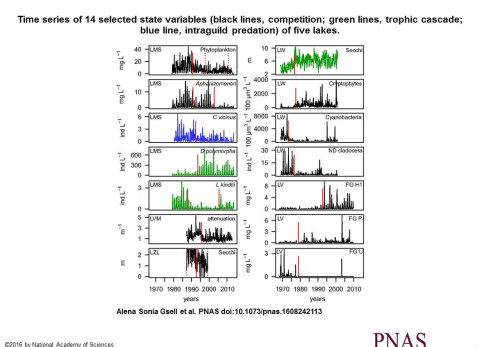Testing early warning signals for crises, in lakes

Testing early warning signals for crises, in lakes
The term 'tipping point' has become popular to describe sudden and fundamental changes that take place even though exterior conditions haven’t changed as radically.
Think of a financial crisis. Think of a wall that will fall down - the Berlin Wall - or another one that will end up being built somewhere else just as suddenly. And what’s true for human society is also true for ecosystems: in shallow lakes, clear, limpid water may suddenly turn into smelly green soup.
Once such a 'regime shift' has occurred, it's difficult or even impossible to get things back to the way they were. But that doesn't mean there are no alarm signals. There is in fact a whole range of statistical indicators that have been proposed as possible early warnings.
Five lakes
An international team led by NIOO-researcher Alena Gsell - formerly of the Leibniz Institute of Freshwater Ecology and Inland Fisheries in Berlin - has now for the first time tested the potential of four of these indicators to be applied to a wide range of lakes.
“We’ve looked at five lakes for which long-term monitoring data (16-34 years) is available”, explains Alena Gsell. One of them is the Veluwemeer in the Netherlands, another Lake Washington in the United States.
The good news is that in some cases, early-warning indicators were indeed detected up to several years ahead of the moment when a 'regime shift' would take place. "That leaves some time for water managers to step in and take appropiate measures."
Less resilient
These indicators show that the resilience of lake ecosystems becomes less ahead of a regime shift.
“It’s something you can observe if you know an ecosystem well”, says Gsell. Perturbations become bigger: water turns turbid temporarily, smaller zooplankton species are favoured and edible green algae lose ground to the less tasty bluegreens.
But on the whole, the team’s tests produced many negative results as well. According to Gsell, this mixed outcome shows that the early warning indicators do hold promise as a method, but are not yet as suitable for general application as had been hoped by many.
Higher frequency
For the early alarm signals to be more effective, argue the researchers, collecting long term data - an essential “window into the past” - isn’t the only thing that’s important. The methods for mining the data also need to become more advanced. More frequent data collection would help: per day or even hour, instead of per week or less.
“If you look at the current state of the environment, investing in the adaptation of indicator methods would definitely be an effort well spent.”
__________________________________________________________________________
The NIOO counts more than 300 staff members and students and is one of the largest research institutes of the Royal Netherlands Academy of Arts and Sciences (KNAW). The institute specialises in water and land ecology. Since 2011, the institute is located in an innovative and sustainable research building located in Wageningen, the Netherlands. The institute has an impressive research history stretching back 60 years and which spans the entire country and beyond its borders.
More information:
-
Lead author Alena Gsell, +31-(0)6-27303368 / +31-(0)317-473531, a.gsell@nioo.knaw.nl
-
Head of the Aquatic Ecology Department and co-author Prof. Ellen van Donk, tel. +31-(0)317-473537 / +31-(0)6-13412894, e.vandonk@nioo.knaw.nl
-
Science information officer Froukje Rienks, NIOO-KNAW, tel +31 (0)6-10487481 / +31 (0)317-473590, f.rienks@nioo.knaw.nl
Article: Evaluating early-warning indicators of critical transitions in natural aquatic ecosystems, Alena Sonia Gsell, Ulrike Scharfenberger, Deniz Özkundakci, Annika Walters, Lars-Anders Hansson, Annette B. G. Janssen, Peeter Nõges, Philip C. Reid, Daniel E. Schindler, Ellen van Donk, Vasilis Dakos & Rita Adrian, Proceedings of the National Academy of Sciences (PNAS), 23 november 2016 (Early Edition, alvast online voorafgaand aan officiële uitgave in tijdschrift), www.pnas.org/content/early/2016/11/21/1608242113.full
Institutions involved: Leibniz Institute of Freshwater Ecology and Inland Fisheries (Duitsland); Nederlands Instituut voor Ecologie (NIOO-KNAW); Free University of Berlin (Duitsland); Waikato Regional Council (Nieuw Zeeland); US Geological Survey (VS); Lund University (Zweden); Wageningen University; Estonian University of Life Sciences (Estland); Sir Alister Hardy Foundation for Ocean Science (VK); Plymouth University (VK); Marine Biological Association of the United Kingdom (VK); University of Washington (VS); ETH Zürich (Zwitserland)
